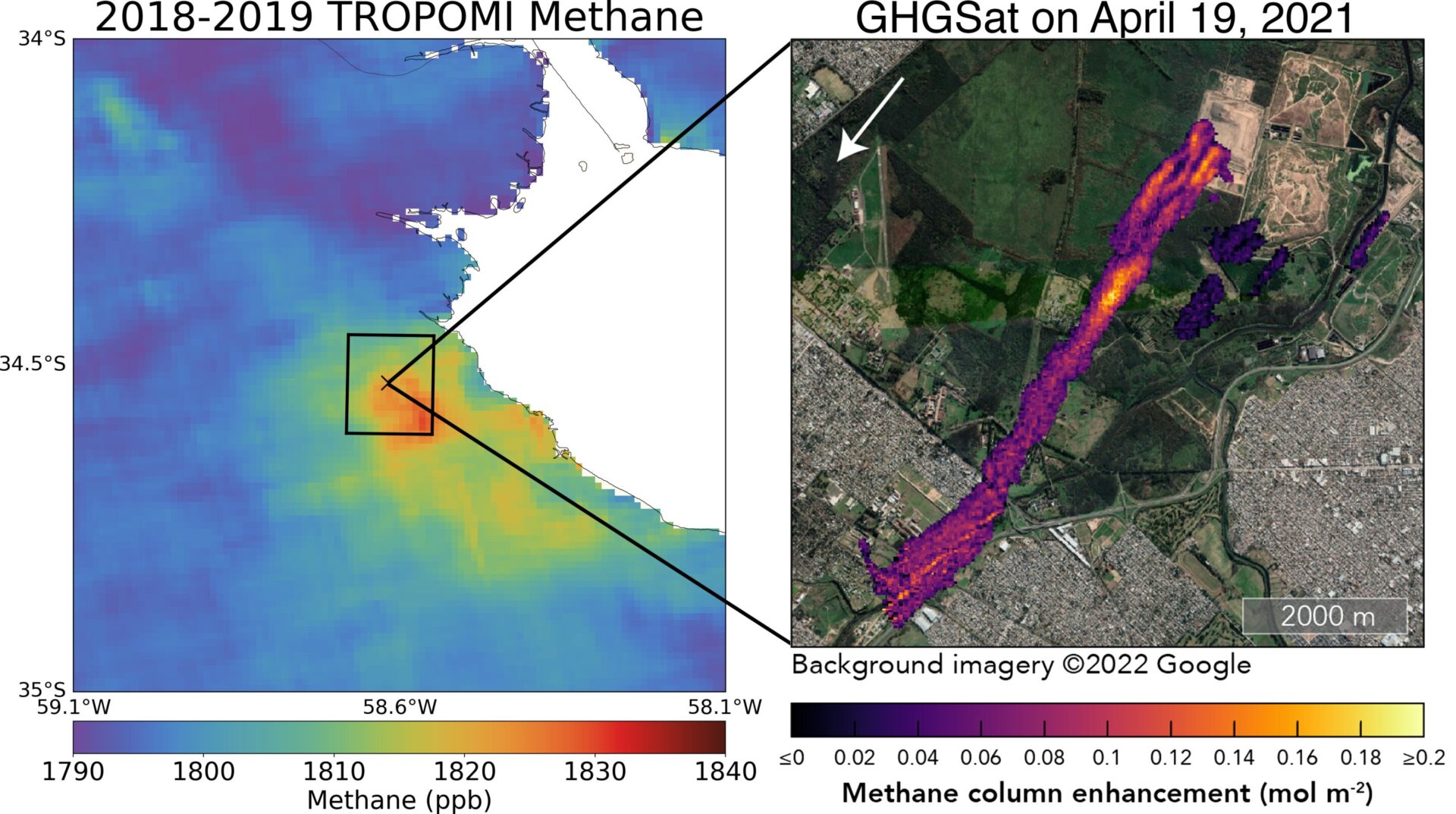
Methane is almost thirty times more powerful as a greenhouse gas than CO2. SRON researchers therefore scan the entire globe for large methane leaks. A landfill in Buenos Aires turns out to emit tens of tons of methane per hour, comparable to the climate impact of one and a half million cars. They also detect large emissions from landfills in India and Pakistan, identifying new low-hanging fruit in the battle against climate change. Publication on August 10th in Science Advances.
Methane is the second largest anthropogenic contributor to the greenhouse effect, after CO2. This is due to its large Global Warming Potential (GWP-100): over 100 years, methane is per ton almost thirty times more potent as a greenhouse gas than CO2. When methane is released through human activity—oil installations, coal mines, cattle sheds, or landfills—it can be made less harmful by flaring it and thereby converting it to CO2. Even better, if you capture it you can put it to good use in your boiler or stove. Researchers from SRON Netherlands Institute for Space Research have now used satellite data to locate a number of landfills that are low-hanging fruit in the fight against climate change. Four landfills in Argentina, India, and Pakistan emit several or even tens of tons of methane per hour.
The SRON methane research team used the Dutch space instrument Tropomi to identify cities with high methane emissions. Buenos Aires, Delhi, Lahore, and Mumbai stood out, with urban emissions on average twice as high as estimated in global inventories. Next, the team asked the Canadian satellite GHGSat to zoom in, which revealed that landfills are responsible for a large fraction of emissions in these cities. The landfill in Buenos Aires emits 28 tons of methane per hour, comparable to the climate impact of one and a half million cars*. The three other landfills are responsible for resp. three, six and ten tons of methane per hour, which still amounts to the impact of 130,000 to 500,000 cars.
‘Methane is odorless and colorless, so leaks are notoriously difficult to detect,’ says lead author Bram Maasakkers (SRON). ‘But satellites are ideally-suited for this. With Tropomi we detect super-emitters that pump large amounts of methane into the atmosphere. That is painful to watch because you can solve it with relatively little effort. You could for example separate and compost the organic waste, which would drastically reduce methane production. And even in the case of mixed waste, you can still collect or flare the methane produced. Methane has a lifetime of only about ten years in the atmosphere, so if we act now, we will quickly see results in the form of less global warming. Of course, reducing methane emissions is not enough, we also need to limit CO2, but it does slow down near-term climate change.’
*Based on the estimate from the American Environment Protection Agency (EPA) of 4.6 tons CO2 that a typical passenger vehicle annually emits. LINK
Original Article: Methane satellites find landfills with the same climate impact as several hundred thousand cars
More from: Netherlands Institute for Space Research
The Latest Updates from Bing News
Go deeper with Bing News on:
Methane satellites
- Study says microbes, not fossil fuels, produced most new methane
Studies in the past have pointed to microbes like anaerobic archaea as potentially top contributors of atmospheric methane using satellite data. But according to Dr. Patra, “Most studies which use ...
- Signs of progress in the heart of a global methane hotspot
Roughly half a century ago, geologists exploring for hydrocarbons accidentally shattered the roof of a huge underground gas deposit opening a crater 60m wide.
- Damage from methane adds to pressure for carbon levy
Australia is part of a global pledge to cut methane emissions by 30 per cent by 2030, with fossil fuel producers, livestock and landfill among the main culprits worldwide.
- Australia’s major polluters could be emitting twice as much methane as reported: Study
Methane is responsible for around 30 per cent of the rise in global temperatures since the industrial revolution. Read more at straitstimes.com.
- Coal mine methane twice official disclosures: Sims
Australia’s open cut coal mines could be emitting twice as much methane as official disclosures suggest, casting doubt on national carbon emissions data.
Go deeper with Bing News on:
Methane from landfills
- World’s first plasma process converts methane to sustainable jet fuel
Imagine a world where our waste becomes the fuel for clean transportation. Researchers at the University of Sydney have taken a significant leap toward that future by developing a novel process that ...
- Methane emissions from landfill could be turned into sustainable jet fuel in plasma chemistry leap
Researchers have developed a chemical process using plasma that could create sustainable jet fuel from methane gas emitted from landfills, potentially creating a low-carbon aviation industry.
- Australian researchers eye sustainable aviation fuel from landfill gases
Australian researchers have developed a chemical process that could produce sustainable aviation fuel from landfill gases as a way of cutting carbon emissions, they said on Wednesday.
- Why scientists are making jet fuel from landfill gas
STORY: What if the carbon dioxide and methane that this landfill emits could power an airplane... ...and reduce greenhouse gas emissions at the same time? Australian ...
- Methane emissions from landfill could be turned into sustainable jet fuel with plasma-driven process
In a world first, University of Sydney researchers have developed a chemical process using plasma that could create sustainable jet fuel from methane gas emitted from landfills, potentially creating a ...










